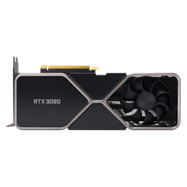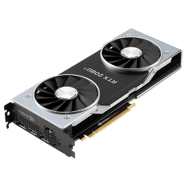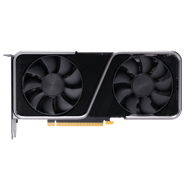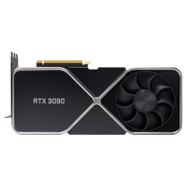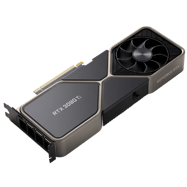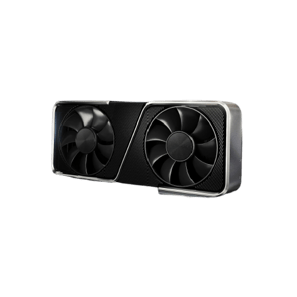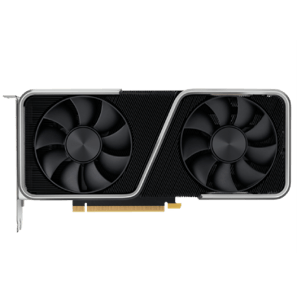The most used graphics cards by VALORANT players
The most popular graphics cards are calculated based on 404 professional players.
Introduction
A lot of people initially doubted Riot’s ability to make a competitive shooter that was more than a flash in the pan, but they’ve really done it with VALORANT. The game has a successful and thriving esports scene, and it has managed to attract a ton of new players to the genre of competitive shooters. It has grown into a serious shooter and a respectable esports game, and we have to give Riot credit for that.
With a serious first person shooter also come serious players: if you want to make it to the top ranks you’ll need your aim to be on point and keep your wits about you, but you’ll also want to make sure that you get enough frames per second. Pretty much every competitive shooter player is playing on a rig and monitor that’s capable of displaying at least 144 frames per second, which gives them an undeniable advantage over players on a 60Hz setup. As of today, the professional standard is 240Hz, but with 360Hz monitors becoming more and more common (and even 1440p 360Hz monitors with IPS panels that rival the response times of TN panels are coming out) we might see a shift in the (near) future.
Luckily, VALORANT isn’t terribly hard to run. If you want to be successful as an esports game you want your game to be as accessible as possible, and Riot have done a great job here. VALORANT is nicely optimized and will run smoothly on even low-mid tier hardware, so if you want to build a PC gaming setup for competitive VALORANT gameplay you won’t have to shell out the big bucks for the absolute top tier components.
We’ve unleashed our analysts and had them come up with this list of graphics cards that should suit every budget and build out there so that you don’t have to do the research and can just get to fragging!
Disclaimer
The Pro Usage Top 5 gets updated daily so that you can get an up-to-date overview of what the pros are using at any given time, which includes discontinued cards. In the body of the article we will focus on cards that are currently available for purchase.
What makes a GPU good for VALORANT?
Every single one of our analyzed Valorant professionals is using a setup that’s capable of displaying at least 144 frames per second, with 90% being on a 240Hz (or higher) setup. Going by what the pros use it’s thus a certainty that you’ll want a GPU that’s capable of displaying the game at 240 frames per second.
These days, graphics cards are powerful enough to run a game such as Valorant at high framerates, even if you’re on a budget. The fact that graphics cards (and PC components in general) are getting more and more powerful with each generation makes it so that 360Hz monitors can be seriously considered these days, and some even consider 1440p 360Hz gaming to be the way of the future, though the components and equipment needed to run the game comfortably at those framerates will cost a lot of money since the tech is rather new.
Of course it’s quite possible that your card can churn out enough frames but that you don’t have the budget for a 240Hz (or 360Hz) monitor, so we’re aware of the fact that a 240 frames per second setup isn’t for everyone. If you are tight on money you can definitely go for 144 but we wouldn’t recommend going any lower if you’re at all serious about the game. For games such as Valorant, going for a higher refresh rate offers plenty of benefits that can and will make you a better player. It’s not a magic ‘go up X amount of ranks’ kind of thing (that doesn’t really exist) but as you can read in our article the benefits are well worth the investment.
So, you’ll need a dedicated graphics card that’s capable of pushing at least 144 frames per second (but ideally 240 or 360) if we’re going by what the pros are doing. Luckily Riot made good on their promise and they didn’t make Valorant a super demanding game, meaning that you don’t automatically have to go for the most expensive, top tier GPUs depending on what your expectations are as far as framerates go. We’ve listed a bunch of options so that you can make an informed decision that suits your budget and build, but don’t forget that it’s important that you get a balanced build. It doesn’t make sense to go for an RTX 3080 if you’re going to be pairing it with a budget CPU and 8GB of RAM, for example.
NVIDIA Reflex
With the release of their 30 series of cards, Nvidia also released their ‘Reflex Low Latency Technology’, which is (in their words) a ‘low latency gaming platform.’ This is a technology that allows you to do two things: namely measure your system latency (and as such find out if there’s a latency problem somewhere) and reduce your system latency. The low latency mode does that by making your CPU work together with a Reflex-capable GPU (GeForce 900 series and up) more efficiently. How this works exactly takes a long explanation (see here for Nvidia’s article and here for our own more surface level article) but it’s safe to say that a lower system latency is always better so this is definitely a feature that’s worth experimenting with. If you already have a high tier setup the results won’t be as noticeable, but if you come from a 60Hz setup there are some real gains to be made here.
Do note that the latency analyzer feature doesn’t work with all peripherals. You need a compatible monitor and compatible peripherals. See here for an updated list.
NVIDIA GeForce RTX 3070
NVIDIA Reflex Compatible
NVIDIA GeForce RTX 3070
Used by 22 Valorant players ()The GeForce RTX 3070 is part of the 30 series of graphics cards, made by NVIDIA. These succeeded the 20 series of graphics cards.
Specs
| NVIDIA CUDA Cores | 5888 |
|---|---|
| Boost Clock | 1.73GHz |
| Memory Size | 8GB |
| Memory Type | GDDR6 |
If you’re someone who enjoys playing a variety of games (including more graphically demanding single player games) on the side after you’ve gotten your competitive fix then it’s hard to beat the RTX 3070.
Naturally, this card will have no problems running Valorant at higher refresh rates, and it will keep churning out enough frames to enjoy a buttery smooth 360Hz refresh rate even at 1440p. Playing at a 4K resolution is not something that we recommend if you’re a competitive gamer but this card should be able to handle that without a lot of issues even at higher refresh rates.
This might be our favorite card of the 30 series, so we can’t recommend it enough.
NVIDIA GeForce RTX 4070 Ti
NVIDIA Reflex Compatible
NVIDIA GeForce RTX 4070 Ti
Used by 11 Valorant players ()The GeForce RTX 4070 Ti is part of the 40 series of graphics cards, made by NVIDIA. These succeeded the 30 series of graphics cards.
Specs
| NVIDIA CUDA Cores | 7680 |
|---|---|
| Boost Clock | 2.61GHz |
| Memory Size | 12GB |
| Memory Type | GDDR6X |
If you want to future-proof your build because you’re planning on going for a 360Hz 1440p (or higher) monitor or you also enjoy playing other, more demanding games, then the 4070 Ti is a good option.
It’s going to run the game with ease at 1440p (even with the graphics turned up) and 4K gaming also isn’t a problem at those framerates, with the 4070 Ti falling just below the 360 frames per second mark with the graphics turned up to the max.
As a dedicated VALORANT card, this is overqualified, but as a general graphics card in a PC build that’s ready for the future this is a great choice.
NVIDIA GeForce RTX 3060
NVIDIA Reflex Compatible
NVIDIA GeForce RTX 3060
Used by 3 Valorant players ()The GeForce RTX 3060 is part of the 30 series of graphics cards, made by NVIDIA. These succeeded the 20 series of graphics cards.
Specs
| NVIDIA CUDA Cores | 3584 |
|---|---|
| Boost Clock | 1.78GHz |
| Memory Size | 12GB, 8GB |
| Memory Type | GDDR6X |
This is the ‘budget option’ in the sense that it is the cheapest available card in this list, but that doesn’t mean that you’re going to get budget performances out of it in VALORANT. All of these cards are powerful enough to run a game like VALORANT with relative ease, so this RTX 3060 will run the game without any hiccups at 144 frames per second, 240 frames per second, and even 360 frames per second if you lower the graphics and are playing at 1080p. If you’re planning on going for a dedicated 360Hz setup, we would recommend a more powerful card though, as this does dip under those framerates at times, something that more powerful cards don’t really do.
If you’re planning on gaming at higher resolutions this will still get the job done (except on 4K) at 240Hz and lower, so if you’re absolutely sure that you’re going to be focusing on Valorant and you will never want to play more demanding games (or you don’t mind turning the settings down for those) this is a great buy.
NVIDIA GeForce RTX 4090
NVIDIA Reflex Compatible
NVIDIA GeForce RTX 4090
Used by 7 Valorant players ()The GeForce RTX 4090 is part of the 40 series of graphics cards, made by NVIDIA. These succeeded the 30 series of graphics cards.
Specs
| NVIDIA CUDA Cores | 16384 |
|---|---|
| Boost Clock | 2.52GHz |
| Memory Size | 24GB |
| Memory Type | GDDR6X |
If you want to go absolutely all out and you want to also play other games at max settings, then the RTX 4090 is the card to go for, but as a dedicated VALORANT card there are better options out there if you’re looking at price/performance values. The 4090 will run VALORANT with absolute ease, and even at 4K resolutions with max settings it’ll nicely stay above the 360 frames per second mark. Drop those settings down to low/medium and you’ve got ~100 frames per second more, so this is the card to go for if you want an absolute top tier setup and you don’t want to worry about upgrading anytime soon.
This is one to consider if you have a 4K setup and you want to play VALORANT maxed out at 4K, but if you’re going for lower resolutions you can save cash by opting for a lower tier GPU.
Best GPU for VALORANT – Conclusion
As you’ve no doubt been able to see VALORANT isn’t a very demanding game. Riot set out to make a game that runs well even on budget hardware and as far as we can tell they’ve really succeeded on that front.
Reaching the competitive standard refresh rate of 240 frames per second is an absolute breeze for the newest generation of GPUs, so which one you get will mostly depend on your budget and your other gaming needs to be honest.
Pros of course always go for the best of the best (you can read why here) so they always trend towards the higher end cards. If budget is no issue you can of course do the same but otherwise a mid to low tier current gen card seems like the best option for this game.
Thanks for reading!


